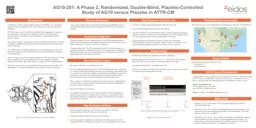

1 ATTRCM occurs when transthyretin amyloid fibrils aggregate and deposit in the myocardium resulting in an infiltrative restrictive cardiomyopathy characterized by both right and left heart failure initially with preserved ejection fraction ID: 930476
Download Presentation The PPT/PDF document "Background Transthyretin (TTR) amyloid c..." is the property of its rightful owner. Permission is granted to download and print the materials on this web site for personal, non-commercial use only, and to display it on your personal computer provided you do not modify the materials and that you retain all copyright notices contained in the materials. By downloading content from our website, you accept the terms of this agreement.
Slide1
Background
Transthyretin (TTR) amyloid cardiomyopathy (ATTR-CM) is an increasingly recognized form of heart failure for which there are no currently approved therapies
1
ATTR-CM occurs when transthyretin amyloid fibrils aggregate and deposit in the myocardium, resulting in an infiltrative, restrictive cardiomyopathy characterized by both right and left heart failure, initially with preserved ejection fraction
The disease results in progressive morbidity and high mortality due to the lack of disease-modifying therapies and limited responsiveness to standard heart failure treatmentsThe initiating step of disease pathogenesis is the destabilization of the TTR tetrameric protein into its constituent monomers and subsequent misfolding into amyloid fibrilsAG10 is a highly selective and potent stabilizer of TTR that mimics the T119M rescue mutation and has the potential to become a disease-modifying treatment for patients with either mutant or wild-type ATTR cardiomyopathy2AG10 was found to be well-tolerated and demonstrated near-complete TTR stabilization in a recently completed Phase I study in healthy volunteers3
Figure 1: AG10-TTR binding mimics T119 rescue mutation
Primary Endpoints
The primary endpoint is to characterize the safety and tolerability of AG10 administered to adult patients with symptomatic ATTR-CM over 28 days of dosing.
Secondary Endpoints
Pharmacokinetics: The PK measurements of AG10 and metabolite will be performed by a designated bioanalytical laboratory after the first dose and at steady state (Day 14, Day 28), and then at follow up.
Pharmacodynamics: The PD measurements of AG10 will be assessed by prealbumin levels and established assays of TTR stabilization, including FPE assay and Western blot, and to describe the PK-PD relationship of AG10 in adult patients with symptomatic ATTR-CM.
Key Inclusion Criteria
Be a male or female ≥18 to ≤90 years of age.Have an established diagnosis of ATTR-CM with either wild-type transthyretin or a variant transthyretin genotype (assessed by genotyping, with patients with concurrent monoclonal gammopathy of undetermined significance requiring a confirmatory test using mass spectrometry) as defined by either positive endomyocardial biopsy or positive technetium pyrophosphate scan.Have a history of heart failure evidenced by at least one prior hospitalization for heart failure or clinical evidence of heart failure (without hospitalization) requiring medical management.Have NYHA Class II-III symptoms.For patients taking cardiovascular medical therapy, with the exception of diuretic dosing, must be on stable doses (defined as no greater than 50% dose adjustment and no categorical changes of medications) for at least 2 weeks prior to Screening.
Key Exclusion Criteria
Acute myocardial infarction, acute coronary syndrome or coronary revascularization within 90 days prior to Screening.Experienced stroke within 90 days prior to Screening.Has hemodynamic instability at Screening or Randomization that, in the judgment of the PI, would pose too great a risk for participation in the study.
Study Design
Randomized, double-blind, placebo-controlled, multicenterEligible subjects will be randomized in a 1:1:1 ratio to AG10 400 mg twice daily, AG10 800 mg twice daily, or matching placebo for 28 days49 subjects randomized (~ 16 subjects per arm)Following completion of double-blind treatment phase, subjects may continue in a separate open-label extension study
Figure 2: AG10-201 Study Schema
Participating centers (map)
Nine centers across the United States ClinicalTrials.gov Identifier: NCT03458130
Study Update
Enrollment complete as of 18 June 2018:Screened 53Randomized 49
AG10 Future Development
A global phase 3 study in patients with symptomatic ATTR-CM is planned to begin in 2019. If you are interested in becoming a study site or interested in a list of sites in your area that will accepting patients for enrollment, please contact: Eidos Therapeutics, Inc.101 Montgomery St, STE 2550San Francisco, California 94104Phone: 415-887-1471 Email: info@eidostx.com
AG10-201: A Phase 2, Randomized, Double-Blind, Placebo-ControlledStudy of AG10 versus Placebo in ATTR-CM
References
Ruberg FL, et al. Transthyretin (TTR) Cardiac Amyloidosis Circulation. 2012;126:1286-1300.
Penchala S. et al. AG10 inhibits amyloidogenesis and cellular toxicity of the familial amyloid cardiomyopathy-associated V122I transthyretin. Proc Natl Acad Sci USA 2013, 110:9992-7.Hellawell J, et al. AG10, A novel, potent and selective transthyretin stabilizer, is well tolerated at doses resulting in target therapeutic blood levels, and demonstrates clinical proof-of-concept in healthy volunteers. Heart Failure Society of America, Nashville, TN. September 15, 2018.
ATTR-CM – Transthyretin amyloid cardiomyopathy; NYHA – New York Heart Association;
TcPYP – Technetium Pyrophosphate; PK – Pharmacokinetics; ECG – electrocardiogram; ECHO – echocardiogram
Patients with symptomatic ATTR-CM
NYHA II-III
Positive biopsy or Tc PYP scanNegative serum light chainsN=49
Screening Period
Double BlindTreatment Period
Screening
Randomization
Day 14
Day 28
< 28 days
Labs
ECG
Labs
PK
ECG
Biomarkers
ECHO
LabsPKECGBiomarkers
LabsPKECGBiomarkers
400 mg AG10 twice dailyn = 16800 mg AG10 twice dailyn = 16Placebo to match twice dailyn = 16
Key Exclusion Criteria cont.
Is likely to undergo heart transplantation within the next year.Has confirmed diagnosis of light-chain amyloidosis.Has abnormalities in clinical laboratory tests or clinically significant ongoing medical condition at Screening or Randomization that, in the judgment of the PI, would pose too great a risk for participation in the study.Current treatment with diflunisal, tafamidis, green tea, doxycycline, TUDCA/Ursodiol, Patisiran or Inotersen within 14 days or 5 half-lives of the prior investigational agent (whichever is longer) prior to Screening.